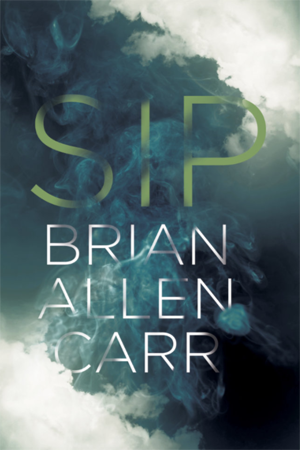
‘Sip’ Seeks Dystopian Depth, and Fine Dining, in the Shadows
Brian Carr’s debut novel is a fast-paced summer read that doesn’t fully deliver on its dystopian premise.

SOHO PRESS
$26.00; 304 pages
The tricky part about a fantasy conceit shaping a novel is that it must seem sufficiently plausible, at some level, to entice readers to press on with Coleridge’s “willing suspension of disbelief.” This is especially so with dystopian fiction, since the imaginary premise has to engage real human fears.
The conceit of Brian Allen Carr’s debut novel, Sip, is that somehow, 150 years from now, humans inhabit a mysterious post-disaster world that has generated mutants who “sip” shadows. They’re somehow highly addictive, but in return allow the consumers to sleep, get high, shape-shift and float in the air like kites. Kind of like what would happen if you downed a Red Bull-tequila-Valium cocktail.
From there, Carr, a past winner of the Observer’s short story contest, spins a tale of young adult characters in search of their identities amid the dismal, violent, Hobbesian world into which they have been born. The questing is all about the shadows — drinking, stealing, amputating, regenerating and concealing them.
The surviving society, at least the one set in what used to be Texas, is divided into three communities. The first is for the “shadow addicts” and houses two of our major players, Mira and Murk. Segment two is for the Domers, a quasi-militaristic bunch who purposely sequester themselves in protective domes so they won’t become contaminated by shadow fever. For some reason the Domers also ride around in trains full of sharpshooters who drop any shadow-sippers roaming the arid terrain. The members of group three are ninja-like young women who have magically learned to control their own shadows so no one can steal them. It also has turned them into marauding psychopaths who exterminate anyone, or any town, that comes into their path.
This scenario may bring to mind a number of post-apocalyptic horror yarns. The zombie franchise The Walking Dead also features human-monster segregation. The Domer train is similar to the one in the film Snowpiercer, where a small group of humans (the privileged separated from the proles) ride a train endlessly through a post-disaster winterscape. The general bleakness and freak violence also echoes something from The Book of Eli.
Sip is a decent summer read: fast-paced and generally minimalist, with extremely short chapters, often nothing more than a paragraph. This structure forces the reader to be a page-turner. And yet there is the issue of the shadow.
Sure, this device replaces vampire blood and zombie body-feasting, but it’s really difficult to gauge how it works. On one hand, shadows have enough something in them to induce physical effects on those who somehow can drink them. On the other, they are simply the product of variable lighting. How can they be shape-shifting crack? The book also delves philosophically into whether a shadow belongs to its host or is something that can be detached, and then bought or sold or traded to others. These arguments are like those that come after a little too much vino or inhaling and seem profound only in the moment.
It’s not that the imaginative realm of fiction must be restricted by facts. Harry Potter and the entire Marvel franchise demonstrate quite the opposite. Frank Herbert’s psychedelic Dune comes to mind, as well as East Texas gem Joe Lansdale’s freaky brilliant Bubba Ho-Tep. It’s that fictive concepts should be compelling.
On its own terms, Carr’s book works well enough. It isn’t even so hard to imagine Sip as the basis for a Netflix series. Stranger Things certainly seems akin. Film or visual equivalents are relevant because Sip is in many ways a graphic novel without the graphics. The characters invite mental fleshing out and would lend themselves to break-out casting. Production would be a breeze, because the scene exteriors and interiors already exist not only in our shared pop-culture memories, but on production lots or readily available landscapes (hey, shoot this in Texas!).
Or maybe Sip will generate a sequel in which the basic premise gets a little more oomph. Along the way, Carr can pick among many sure-footed guides, but perhaps the most relevant might be The Road, to name but one master class in dystopia from Cormac McCarthy. It’s all very violent and nightmarish, but there is a connection to our world that powers it like a muscle car on I-10.
William Gibson recently assessed the proliferation of dystopian fiction, trying to figure what, in the recent flood of such literature, works. “I think I aspire to naturalism, which today is easily mistaken for dystopian,” Gibson told Vulture. He said naturalism creates a “necessary balance” in fiction because in the actual world, dystopia, which already exists in many parts of the globe, is “not very evenly balanced” at all. Pretty much what Coleridge was getting at.


